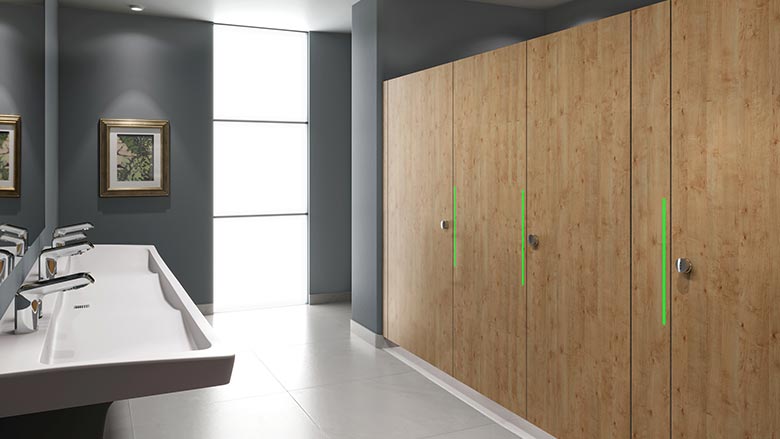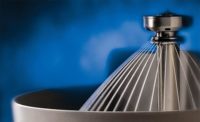The pandemic forever changed the way people think about commercial bathrooms. The increased focus on hygiene spurred an increased adoption of touchless fixtures and sensor technologies. The products in this space continue to evolve, ensuring maintenance of these products is easier than ever.
PM Engineer Chief Editor Nicole Krawcke had the chance to chat with Jon Dommisse, Bradley Corp.’s vice president of marketing, to discuss how these commercial restroom trends are evolving in 2023, what the hottest products are and how codes are influencing the design of these spaces.

PM Engineer: Given your experience in the industry, what would you say are the biggest design trends for commercial bathrooms today?
JD: Kind of like how the iPod changed music forever, and 9/11 changed air travel, COVID obviously changed everything about public bathroom design. All of us have heard stories about you were petrified to go out, you didn't want to touch anything. No one ever loved public bathrooms; you're always just trying to make them as pleasant as possible, but COVID really changed that — there was an actual fear of a public bathroom if it wasn't clean. The biggest design trends are centered around more enhanced restroom maintenance because those expectations of cleanliness are so much higher than ever before. People expect restrooms to always be clean, and that's very different than just three or four years ago.
Looking at it from the business perspective, if you have a business that has a public bathroom, it's incumbent upon you to always keep that clean. In our survey, 60% of our respondents said they would willingly spend more money at a business with a well-maintained bathroom, and about 55% said they won't go into a business that they know has an unclean or unkempt public bathroom.
I'm sure you've heard about improved HVAC and air cleaning as well, too. Workplaces are hiring industrial hygienists to test their air and their restroom surfaces because again, employees expect a heightened level of cleanliness. With that heightened level of cleanliness, there's an elevated demand for a better restroom experience, upgraded aesthetics, better materials, an enhanced experience that isn't just functional; it's a more welcoming experience.
We only sold touch-free products for a very long time, but since COVID, certainly not just Bradley, the industry overall, it has dramatically been impacted by higher demands for touch-free products across the board. 80% of the people in our recent survey said that they expect touch-free products to be in a public bathroom. I believe that we're seeing probably the death of the normal traditional handled faucets and other touch-free products in a bathroom. I don't think those will be around much longer, and touch-free everything, faucets and soap dispensers will take their place.

PM Engineer: So besides hygiene, how would you say commercial bathrooms are evolving in 2023?
JD: Definitely touchless fixtures are going to rule the day. When we asked them what should be touchless, like I said, we just kept getting answers of every single thing in a bathroom. We also found that 63% use paper towels to avoid contact with anything. So you see the foot flushers, the people that grab handfuls of paper towels as almost like gloves if they're going to touch things and hovering over toilet seats. I think that all has to do with the expectation that it has to be touchless. The other part is all-in-one hand washing systems. Bradley has our wash bar and we invented that category, not just during COVID, but a couple of years before. Other companies have all-in-one hand washing products too, but just the soap, water and dryer all in that basin is ideal because then there isn't the splash, there isn't water falling on the floor.
There's also a sustainability element because there are not as many maintenance people anymore. Every company you talk to says it's very hard to find facility staff, and that means that they need to reduce their use of paper towels, and all-in-one products help do that. And then probably the other portion is, because people are more cognizant of washing their hands, there's an increased use of hand washing products. So again, it is incumbent upon those facility managers to always be reviewing their restroom cleaning practices, make sure that everything's working. And again, our surveys said the number one irritation in a public bathroom is if there's no soap, no paper towels, something that you have to keep those supplies stocked. Otherwise, you get the rinse-and-run people that are just flinging it everywhere, which obviously doesn't help keep a clean bathroom either.
Many of the customers that we've worked with — architects, specifiers, engineers — on new bathroom designs, have almost universally said that aesthetics are far, far more important than they've ever been. Durability, reliability and functionality type in a bathroom are very important, but they are demanding a lot more colors and finishes. Again, just to make that whole experience a lot better. Black is very popular. I'm sure you've seen a lot more black fixtures when you go into public bathrooms now. Brushed stainless, brushed nickel, brushed bronze. We're getting a lot of demands that they want the faucet and the soap to match that. They just don't want hodgepodge fixtures from 10 companies. They really want to have harmonized design language across the whole system.

PM Engineer: What are the most sought-after products for commercial restrooms?
JD: Certainly touch-free everything. And that does include partitions too, coming out with ways to open and close partitions that might not have to be manual. There's a lot of experimentation going on with that, but higher-end toilet stall partitions and taller sizes, doors that don't have the big space that everybody hates, especially in school and health care environments,have become something that's unacceptable and that's very different. The European-looking designs, they've had those for decades. That's rapidly coming to the U.S. and is certainly something that's going to play, going to generate a higher percentage of share of the toilet partition market. And design isn't always just products that they want. The corridor concept of design for a bathroom, you probably see that the most in airports where they don't have doors, just that “S” serpentine design because that facilitates ADA and no touch.
The corridor concept is definitely being experimented with way beyond airports now into stadiums, convention halls, schools and many other type of applications. Last, but not least, are the gender-neutral and family bathrooms that are being added to schools, stadiums, airports and amusement parks. They're not getting rid of the men's and the women's bathrooms. But the thing that's being added significantly more than anything else are the gender-neutral bathrooms.




